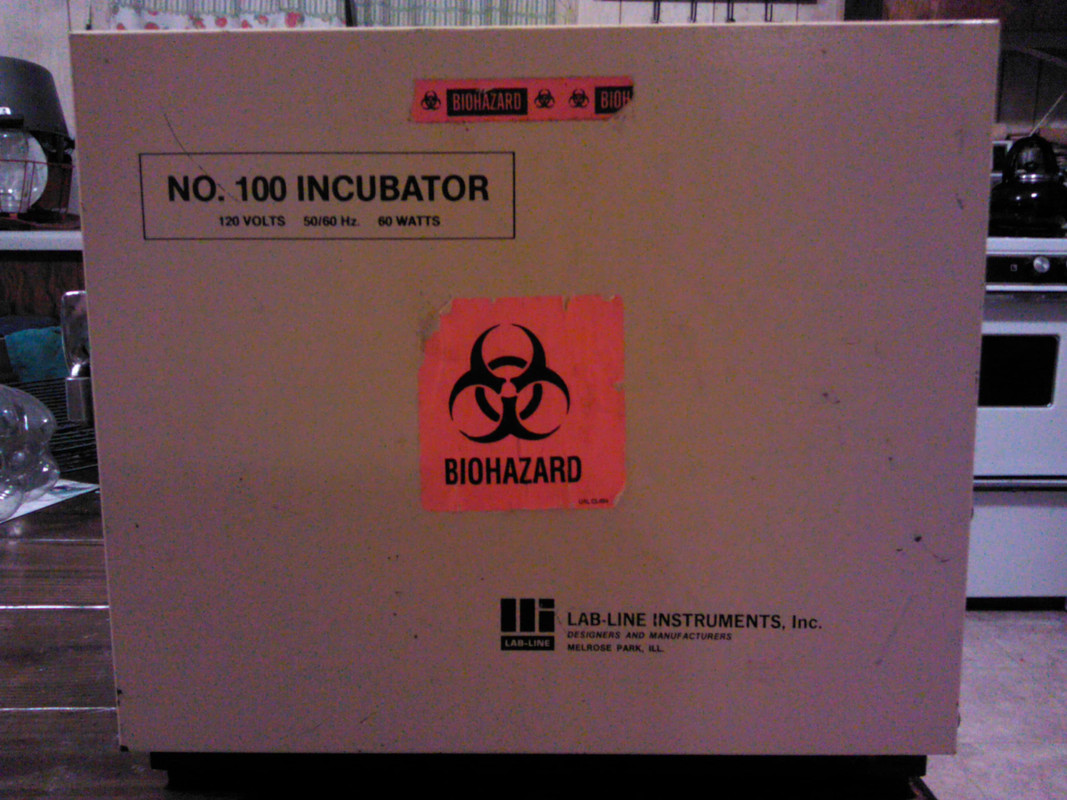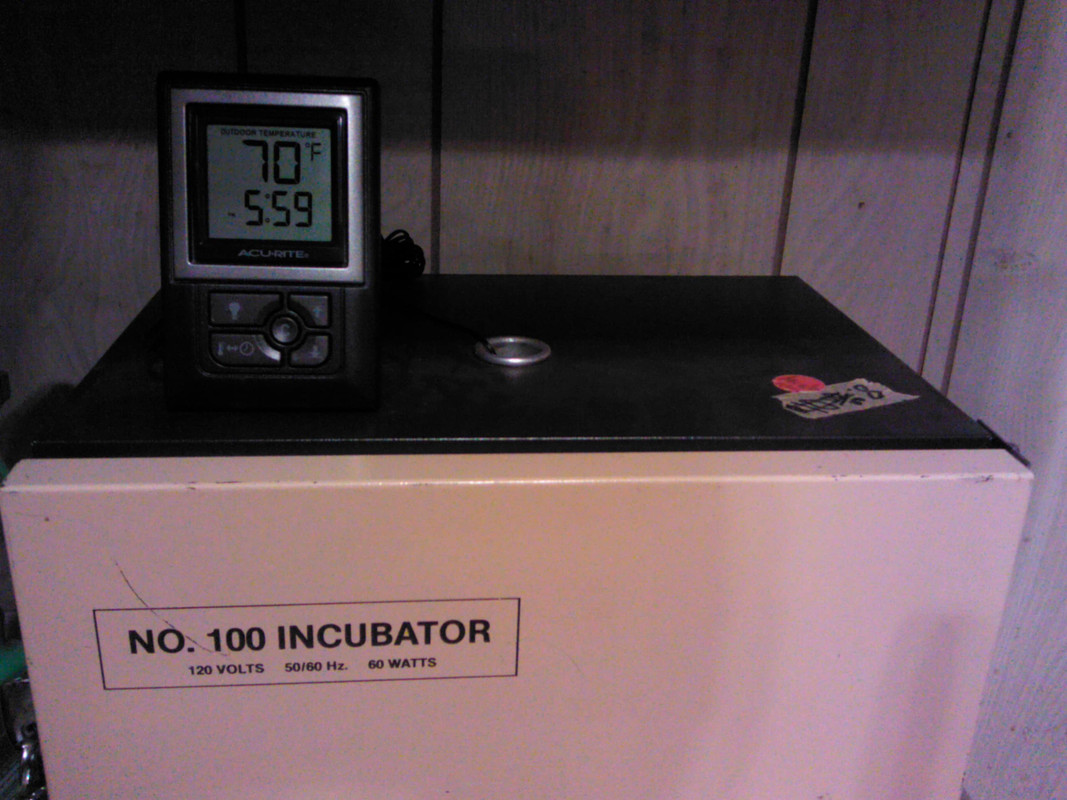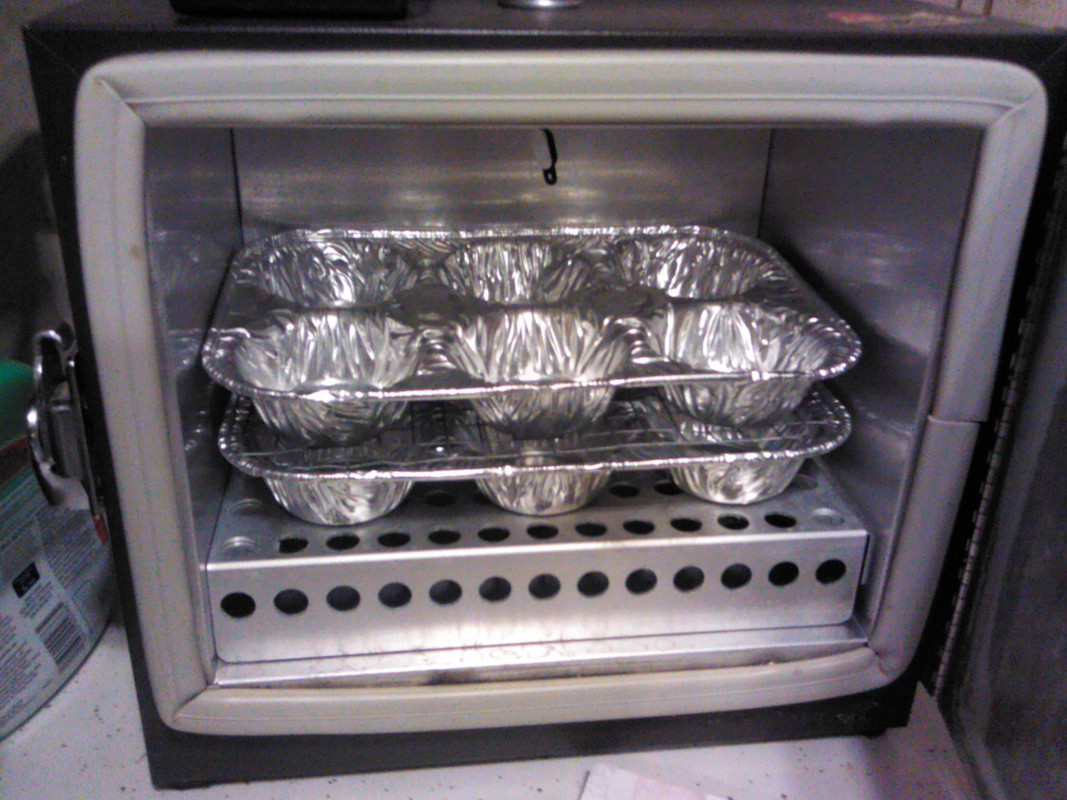|
|
Post by oldmobie on Oct 17, 2014 3:13:36 GMT -5
Now that I'm processing bigger lots of seeds, I'm finding it more difficult to prevent sticking, mildew and mold. I actually built a tumbler to keep them agitated. I didn't have a slow moving motor to attach, so I put vanes on it, making it a horizontal axis wind turbine. Stuck it in front of a fan. Turns by itself, just like I'd hoped. Unless you do something stupid, like put sunflower seeds in it. Then you have to start it by hand. If it spins fast enough to pin the seeds to the wall, it keeps going. Turn the fan down, or move it away so the rotation slows and the seeds tumble, and it stops. It was too noisy anyway. Now my eleven year old has a home-made whirlygig.
New plan. Now the seeds are in a mesh bottomed tub, over a semi enclosed space with a light bulb inside. Keeping the temp within a range from the low 90s to about 110°.
I was going to build or modify a small cabinet with screenwire stretched on wood frames that pull out like drawers, with ventilation top and bottom, so heated air could exit at the top, cool air enter below. I was going to install 2 or 3 light bulbs at the bottom, so it'd still heat if 1 burned out. Behind a baffle, so the lower seeds didn't cook. With a thermostat. And a thermometer for monitoring.
Then my wife noticed I was describing a big, ugly, inefficient dehydrator. Don't know why she's gotta spoil the fun like that. But fine. I need to know about thermostat controlled dehydrators that will dry my seeds but not cook them. Dishwasher safe is a BIG plus. I know it's been done this way. What dehydrator does a good job, and has a thermostat I can set? How much will it cost? Got links?
|
|
|
|
Post by philagardener on Oct 17, 2014 5:53:37 GMT -5
People like the Excalibur dehydrators. They are expensive, but seem very well built. I'm keeping my eye open for one. Used ones show up on line for <$100 but shipping can add a bit. Perhaps someone can comment on the temp of the lowest setting. |
|
|
|
Post by ferdzy on Oct 17, 2014 8:06:34 GMT -5
We have a 9 tray plastic Excalibur, and it's okay, I guess. It was given to us by a friend who decided they were not going to use it. We don't use it much either, because we also have a 10 tray stainless steel dryer from Sausagemaker, and it is absolutely WONDERFUL. Yeah, it was EXPENSIVE too. But this thing will be a family heirloom, it is that good. www.sausagemaker.com/32609d-10fooddehydratorwith14stainlesssteelshelves.aspxStainless steel parts, that disassemble easily and neatly for thorough cleaning. Sturdy and reliable. I just can't recommend it too highly. I believe these are our 4th and 5th food driers, respectively. The first 3 were cheaper plastic models, which were all dead within two seasons, because they couldn't handle the workload we threw at them. Mind you, if all you are going to dry is seeds, maybe a cheapo model will be perfectly adequate. But on the other hand, if you are going to get a dehydrator, you might as well be able to, you know, dehydrate. p.s. the 10-tray Sausagemaker is big enough that we used it to cure almost a bushel of sweet potatoes last week. |
|
|
|
Post by flowerweaver on Oct 17, 2014 17:58:37 GMT -5
For something less expensive, I've had a Harvest Maid dehydrator that I bought 23 years ago that's still doing its job. Since it's plastic I've always hand washed it. It has a dial for setting the temperature. The lowest setting on mine qualifies for raw foods 'cooking', that is, low enough not to harm plant enzymes. I don't know if that would work for seeds, but probably so. You'd have to use the mesh inserts to keep seeds from falling through the grates. Edit: make that 33 years! I knew I left out a decade somewhere...not bad for a small appliance life. |
|
|
|
Post by oldmobie on Oct 23, 2014 21:11:01 GMT -5
 Forgot I had this! My mother-in-law got it at a yard-sale for us years ago. It's still marked" $10.00 $8.00"! She thought it was an egg incubator. (I guess I could use it that way, if I still had eggs.) I had to change the cord. Then I cleaned it with bleach wipes. Then Scrubbing Bubbles. ("Kills 99.9% of germs!") Then 10% bleach solution. Should be sterile. Seems to be holding at 33°-34° C. (91.4°-93.2° F) It's vented top and bottom, but the thermometer fits through a cork and blocks the top vent. I'll need an old-school remote thermometer with a bulb/ capillary type probe, so I can monitor the inside temp without blocking airflow. I doubt that it'll make a good food dehydrator, but I have high hopes for it as a low temp seed dryer. That will free me up to buy a cheaper food dehydrator, since thermostatic control becomes much less critical. |
|
|
|
Post by philagardener on Oct 23, 2014 21:18:24 GMT -5
That "Biohazard" tape is a little disconcerting . . .
|
|
|
|
Post by oldmobie on Oct 23, 2014 21:34:07 GMT -5
That "Biohazard" tape is a little disconcerting . . . I'm trying to break into landrace gardening. That's already a biohazard, right? "Those seeds might not breed true! Lock the doors and hide the children!" |
|
|
|
Post by flowerweaver on Oct 24, 2014 6:12:33 GMT -5
Um...what did this thing once incubate that it should need a biohazard warning?
|
|
|
|
Post by oldmobie on Oct 24, 2014 8:39:28 GMT -5
Um...what did this thing once incubate that it should need a biohazard warning? A sticker on the side says Skaggs Health Systems. (Skaggs ran the Branson hospital until Mercy/ St John's bought it.) I would guess that it was used to culture samples from patients to determine what they were sick with. Anything that was once in it has been long out of a host body. (An inspection sticker indicates it was last inspected in 2000.) Unwarmed, dry, unfed. Then bombarded with household disinfectants. Hard to imagine anything live hanging on through all that. Wish I had a UV light to stick in it from time to time when it's empty. |
|
|
|
Post by flowerweaver on Oct 24, 2014 9:34:43 GMT -5
Be aware household disinfectants don't kill everything--for instance, Marek's in chickens--there's something I buy made specifically for poultry house disinfecting. I've heard Marek's can live for years without a host. I don't think bleach will kill parvo virus either; the vet uses something specific to wipe down the tables. I'm certainly no medical expert, but I would think things that can kill their host quickly probably have a longer lifespan outside of a host.
I once made the mistake of tossing some clothes covered in seed ticks after a hike in another part of the state in the trunk of my car thinking that baking in the heat without a host all summer would exterminate them. Many months later, after cleaning out the trunk, laundering the clothes, and taking them back to my apartment I soon discovered they had not only survived but multiplied to the point they were everywhere, even crawling behind the glass on framed artworks. The health department was not amused and had it sprayed.
|
|
|
|
Post by oldmobie on Oct 24, 2014 11:10:48 GMT -5
Be aware household disinfectants don't kill everything--for instance, Marek's in chickens--there's something I buy made specifically for poultry house disinfecting. I've heard Marek's can live for years without a host. I don't think bleach will kill parvo virus either; the vet uses something specific to wipe down the tables. I'm certainly no medical expert, but I would think things that can kill their host quickly probably have a longer lifespan outside of a host. Noted. In the short term, I'm going to turn it all the way up with water inside. If I can get a good head of steam, maybe it'll autoclave itself. No idea if it gets that hot. We'll see. Longer term, I'll see if I can obtain some hospital/ vet grade spray. In the mean time, I'm not putting seeds or food into it. Somewhere along the way, it may get a peroxide wash. And/ or alcohol. Don't wanna feed the family bad stuff, nor distribute bad stuff along with seeds. |
|
|
|
Post by oldmobie on Oct 24, 2014 16:26:55 GMT -5
In the short term, I'm going to turn it all the way up with water inside. If I can get a good head of steam, maybe it'll autoclave itself. No idea if it gets that hot. We'll see. Didn't get hot enough. Off the scale of my 40°C thermometer, but no boil. Insignificant steam. Longer term, I'll see if I can obtain some hospital/ vet grade spray. Someone I know works in a hospital. Gonna bring me a sample of what they'd use. Then I'll remove the biohazard tags. |
|
|
|
Post by Carol Deppe on Nov 4, 2014 23:52:01 GMT -5
I have two of the big 9-tray Excalibur dehydrators, and up until last spring, recommended them highly. Mine have a lowest temp of about 80 F and are still running fine after thousands of hours of use. But a friend of mine ordered one last spring, and his wouldn't go below about 120. Turns out the factory has decided that the lower temperatures represent a safety and liability issue. I called them and explained about seed saving, to no avail. My friend found out the factory still had some of the old (better) thermostats, and they were willing to ship him one for free for him to use to replace the crappy new thermostat. If you want an Excalibur, better call the factory and see whether they still have any of the old thermostats available. If they don't I would give the Excaliburs a miss and just build something of your own, big and ugly or not.
I probably will do that anyway. I need something much bigger to dry corn on the ear. I saw something I thought perfect at the Oregon State University Hyslop farm seed lab. It was an old corn drier. Probably hand built. Basically a cabinet that held several wire drawers, each about 3' X 4' x 2' deep. A small heater with a fan delivered warm air to the cabinet, and baffles separated the air flow into streams that moved through each rack separately and independently. I really need something like that because the amount of corn I'm dealing with at this point is somewhat overwhelming my ability to dry it in piles and crates indoors. (Here in maritime Oregon, field dry corn is not all that dry. It needs extra drying indoors.) Such a ear-corn drier could be used to dry anything else also by just using screened trays.
|
|
|
|
Post by oldmobie on Dec 12, 2014 19:16:07 GMT -5
I cleaned out my little incubator once more, with the sample of hospital grade cleaner I was given. After that I started using it to dry seeds. I'm pretty satisfied with it, though I'm just starting to germination test. I added an outdoor thermometer with a probe on a wire. Cost around $11, I think. (It's unplugged right now. I run it between 90° and 95°.)  Found a two pack of mini muffin tins that fit really well inside. That cost $1. I'm thinking of adding another set. A piece of hardware cloth between the pans raises the top one for better airflow.  For the scale of my gardening, it works very well. I've put the search for a food dehydrator on the back burner for now. When I decide to buy one, I won't be hampered by concerns of having it work for my seeds. |
|
|
|
Post by steev on Dec 16, 2014 19:27:46 GMT -5
When Holly asked what kind of dehydrator I have, I said "Excalibur"; wrong! It's a two-cabinet, 20-tray Equiflow (they both start with "E", so close enough, eh?). It's ~40 years old and getting close to the knacker; sure could handle a lot of mushrooms or jerky in one loading.
One of my intended projects for the farm is a 10' X 12' drying/canning shed, screened sides for airflow through racks of drying produce in hot season, shutters to close it up for canning in cold (the sort of thing that doesn't need a building permit and can be put up after the county assessor has been and gone. I think it will also serve as a good place, in cold season, to cure some sorts of meat products and ferment stuff.
|
|



